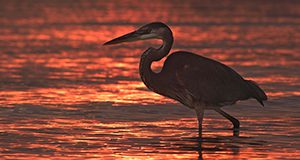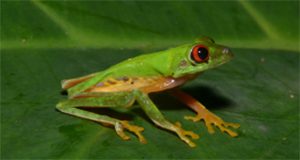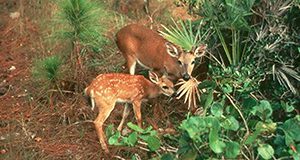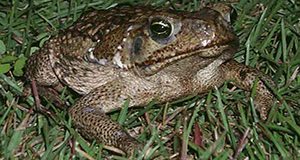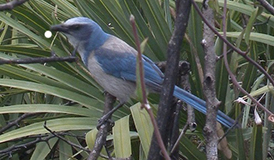Belize is home to over 605 bird species, many of them wading birds popular with bird watchers who enjoy their bright colors and charismatic behavior. Bird-watching is a major contributor to successful wildlife conservation and is important as native habitat loses ground to development. This 4-page fact sheet written by Venetia S. Briggs-Gonzalez, Jorge E. Ruano, Justin R. Dalaba and Frank J. Mazzotti and published by the UF/IFAS Department of Wildlife Ecology and Conservation presents photos and descriptions that will help identify some common and some rare wading birds.
https://edis.ifas.ufl.edu/uw469
Tag: Frank J. Mazzotti
Early Detection and Rapid Response (EDRR) to Nonnative Wildlife in South Florida
Invasive nonnative wildlife threaten successful restoration of Everglades ecosystems in south Florida. If nothing is done while an invasion is in the beginning stages, populations can grow and become much more difficult to manage, as happened with the Burmese pythons. This 4-page fact sheet written by Justin R. Dalaba and Frank J. Mazzotti and published by the UF/IFAS Wildlife Ecology and Conservation Department explains how the Early Detection and Rapid Response method works and how to apply it to increase the likelihood that an invasion will be successfully contained or eradicated while an invasive population is still small and localized.
http://edis.ifas.ufl.edu/uw454
Frogs and Toads of Northern Belize
Belize is home to several threatened frog species. One of them, the Maya mountains frog, lives nowhere else in the world. This 4-page fact sheet written by Jenna M. Cole, Sarah K. Cooke, Venetia S. Briggs-Gonzalez, Justin R. Dalaba, and Frank J. Mazzotti and published by the UF/IFAS Wildlife Ecology and Conservation Department will help you identify your frogs and toads in order to better protect them.
http://edis.ifas.ufl.edu/uw439
Climate Changes, Shifting Ranges: Climate change effects on wildlife in the Florida Everglades and Keys
Where do the animals go when the sea rises? Learn the probable futures of Florida panthers and other south Florida wildlife in this 5-page fact sheet. Written by Larry Perez, James I. Watling, David Bucklin, Mathieu Basille, Frank J. Mazzotti, Stephanie Romañach, and Laura Brandt and published by the UF Department of Wildlife Ecology and Conservation, it explains how a changing climate could impact wild animals.
edis.ifas.ufl.edu/uw428
Ecological Risk Assessment for Invasive Wildlife in Florida
Global trade and travel transport plants and animals from native ranges to new ecosystems. About 10 to 20% of nonnative (exotic, alien) species that arrive in new locales become invasive, meaning they are likely to harm the environment, economy, or public health. Preventing the introduction of invasive species is the most effective way to protect native biodiversity and ecosystem integrity. Once an invader begins to establish and spread, its control costs increase rapidly. Florida ports are the entry points for about half of the reptiles, arachnids, insects, and crustaceans imported into the United States. These arrivals, coupled with hospitable climate and habitats, have made Florida home to more invasive species than any other state but Hawaii. While it is too late to prevent the invasion of Burmese pythons and Argentine black and white tegus, we can act to prevent other potentially destructive species from establishing. This 6-page fact sheet written by Venetia Briggs-Gonzalez, Kyle Allen, Rebecca G. Harvey, and Frank J. Mazzotti and published by the Department of Wildlife Ecology and Conservation explains how to assess the risk that a given invasive species presents to the environment and how to develop and use risk-screening tools to reduce the harmful effects of invasions or, better yet, prevent them entirely.
http://edis.ifas.ufl.edu/uw419
The American Crocodile: An Indicator Species for Everglades Restoration

The American crocodile (Crocodylus acutus) is a top predator that lives along the southern tip of peninsular Florida, inhabiting saltwater, brackish water, or freshwater near coastal areas in mangrove-lined ponds, creeks, coves, man-made ponds, and canals. This 3-page fact sheet written by Rebecca G. Harvey, Michiko Squires, Jeff Beauchamp, Frank J. Mazzotti, and Laura A. Brandt and published by the Department of Wildlife Ecology and Conservation explains how monitoring populations of threatened crocodiles can help scientists chart the success of projects to restore the Everglades.
edis.ifas.ufl.edu/UW422
Considerations for Building Climate-Based Species Distribution Models
Climate plays an important role in the distribution of species. A given species may adjust to new conditions in-place, move to new areas with suitable climates, or go extinct. Scientists and conservation practitioners use mathematical models to predict the effects of future climate change on wildlife and plan for a biodiverse future. This 8-page fact sheet written by David N. Bucklin, Mathieu Basille, Stephanie S. Romañach, Laura A. Brandt, Frank J. Mazzotti, and James I. Watling and published by the Department of Wildlife Ecology and Conservation explains how, with a better understanding of species distribution models, we can predict how species may respond to climate change. The models alone cannot tell us how a certain species will actually respond to changes in climate, but they can inform conservation planning that aims to allow species to both adapt in place and (for those that are able to) move to newly suitable areas. Such planning will likely minimize loss of biodiversity due to climate change.
http://edis.ifas.ufl.edu/uw420
The Argentine Black and White Tegu in South Florida: Population Growth, Spread, and Containment
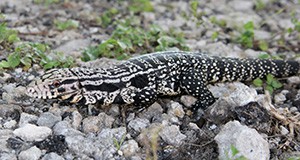
Florida is home to more nonnative species of reptiles and amphibians than anywhere else in the world because of its subtropical climate, large areas of disturbed habitats, and thriving trade in exotic pets. Although pythons have received the majority of public attention, invasive lizards also pose a significant threat to south Florida’s native wildlife and ecosystems, and a good example is the Argentine black and white tegu. Learn more about this exotic lizard in this 3-page fact sheet written by Rebecca G. Harvey and Frank J. Mazzotti and published by the Wildlife Ecology and Conservation Department.
http://edis.ifas.ufl.edu/uw405
Biology of the Hicatee: A Critically Endangered River Turtle of Belize
The hicatee (Dermatemys mawii) is a Central American river turtle and one of the 25 most endangered turtle species in the world. Over-hunting for meat, eggs, and shells is driving the turtles toward extinction. This 3-page fact sheet about the hicatee includes its natural history, reproductive habits, and ecology and describes the international conservation efforts to save the fascinating but fast-disappearing turtle. Written by Venetia Briggs-Gonzalez, Nathan Schwartz, Rebecca G. Harvey, and Frank J. Mazzotti and published in November 2015 by the Wildlife Ecology and Conservation Department.
http://edis.ifas.ufl.edu/uw404
The Invasion Curve: A Tool for Understanding Invasive Species Management in South Florida
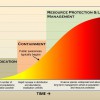 South Florida has more than its share of invasive plants, reptiles, amphibians, fish, mammals, birds, and invertebrates. Nonnative species often spread quickly. Research and monitoring can help managers anticipate which species will cause harm before it is too late to remove them. Identifying where a species is on the invasion curve is the first step to taking management action. The invasion curve shows that eradication of an invasive species becomes less likely and control costs increase as an invasive species spreads over time. Prevention is the most cost-effective solution, followed by eradication. If a species is not detected and removed early, intense and long-term control efforts will be unavoidable. This 4-page fact sheet was written by Rebecca G. Harvey and Frank J. Mazzotti, and published by the UF Department of Wildlife Ecology and Conservation, November 2014.
South Florida has more than its share of invasive plants, reptiles, amphibians, fish, mammals, birds, and invertebrates. Nonnative species often spread quickly. Research and monitoring can help managers anticipate which species will cause harm before it is too late to remove them. Identifying where a species is on the invasion curve is the first step to taking management action. The invasion curve shows that eradication of an invasive species becomes less likely and control costs increase as an invasive species spreads over time. Prevention is the most cost-effective solution, followed by eradication. If a species is not detected and removed early, intense and long-term control efforts will be unavoidable. This 4-page fact sheet was written by Rebecca G. Harvey and Frank J. Mazzotti, and published by the UF Department of Wildlife Ecology and Conservation, November 2014.
http://edis.ifas.ufl.edu/uw392
Alligator Abundance and Hydrology (2003–2013): What Long-term Monitoring Can Tell Us about Everglades Restoration
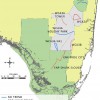 The American alligator is a powerful indicator for Everglades restoration. It responds clearly to environmental change and is easy and inexpensive to monitor. As top predators and ecological “engineers,” alligators affect nearly all aquatic life in the ecosystem. Thus, trends in alligator populations can tell us whether restoration projects are successful. Alligators may be monitored for both short-term responses (body condition) and longer-term responses to ecosystem change (abundance). This 3-page fact sheet discusses trends in alligator abundance. It was written by Rebecca G. Harvey, Jeff Beauchamp, Robin Bijlani, Frank J. Mazzotti, and Laura A. Brandt, and published by the UF Department of Wildlife Ecology and Conservation, July 2014.
The American alligator is a powerful indicator for Everglades restoration. It responds clearly to environmental change and is easy and inexpensive to monitor. As top predators and ecological “engineers,” alligators affect nearly all aquatic life in the ecosystem. Thus, trends in alligator populations can tell us whether restoration projects are successful. Alligators may be monitored for both short-term responses (body condition) and longer-term responses to ecosystem change (abundance). This 3-page fact sheet discusses trends in alligator abundance. It was written by Rebecca G. Harvey, Jeff Beauchamp, Robin Bijlani, Frank J. Mazzotti, and Laura A. Brandt, and published by the UF Department of Wildlife Ecology and Conservation, July 2014.
http://edis.ifas.ufl.edu/uw387
Necropsies of Reptiles: Recommendations and Techniques for Examining Invasive Species
 Captures and postmortem examinations, or necropsies, of invasive or nonnative animals may provide insight into the ecological impact of these invaders. Researchers should be able to perform necropsies when an opportunity arises to examine nonnative species for study. While the techniques described serve as a guide to necropsy of all reptiles, we focus on exotic species found in south Florida. South Florida provides prime habitat for invasive reptiles such as Argentine black and white tegu and Burmese python, and these species are used to describe our techniques. This 26-page fact sheet was written by Seth C. Farris, Michiko A. Squires, Frank Ridgley, Emma Lavergne, Mitchell Serota, and Frank J. Mazzotti, and published by the UF Department of Wildlife Ecology and Conservation, September 2013.
Captures and postmortem examinations, or necropsies, of invasive or nonnative animals may provide insight into the ecological impact of these invaders. Researchers should be able to perform necropsies when an opportunity arises to examine nonnative species for study. While the techniques described serve as a guide to necropsy of all reptiles, we focus on exotic species found in south Florida. South Florida provides prime habitat for invasive reptiles such as Argentine black and white tegu and Burmese python, and these species are used to describe our techniques. This 26-page fact sheet was written by Seth C. Farris, Michiko A. Squires, Frank Ridgley, Emma Lavergne, Mitchell Serota, and Frank J. Mazzotti, and published by the UF Department of Wildlife Ecology and Conservation, September 2013.
http://edis.ifas.ufl.edu/uw382
Native and Nonnative Crocodilians of Florida
 Florida has two native species of crocodilians, the American alligator and the American crocodile. These federally protected species are easily confused with nonnative crocodilians found in south Florida, such as the spectacled caiman and the Nile crocodile. Some key features used to distinguish these animals are the shape of the head, the shape of the snout, and the pattern of nuchal scutes (bony plates in between head and shoulders). It is important to report all nonnative crocodilians so that researchers may quickly remove them in order to protect Florida’s native ecosystems. This 2-page fact sheet was written by Michiko A. Squires, Seth C. Farris, Brian M. Jeffery, and Frank J. Mazzotti, and published by the UF Department of Wildlife Ecology and Conservation, September 2013.
Florida has two native species of crocodilians, the American alligator and the American crocodile. These federally protected species are easily confused with nonnative crocodilians found in south Florida, such as the spectacled caiman and the Nile crocodile. Some key features used to distinguish these animals are the shape of the head, the shape of the snout, and the pattern of nuchal scutes (bony plates in between head and shoulders). It is important to report all nonnative crocodilians so that researchers may quickly remove them in order to protect Florida’s native ecosystems. This 2-page fact sheet was written by Michiko A. Squires, Seth C. Farris, Brian M. Jeffery, and Frank J. Mazzotti, and published by the UF Department of Wildlife Ecology and Conservation, September 2013.
http://edis.ifas.ufl.edu/uw380
Freshwater Turtles of Belize (WEC328/UW373)
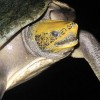 Belize, a country rich in natural resources and diverse wildlife, is home to nine species of freshwater turtles. Among these is the critically endangered hicatee, which has been eliminated in most of its range as a result of hunting and habitat loss. Freshwater turtles live in rivers, creeks, and lagoons, and build their nests on the banks. They eat a variety of plants, aquatic vegetation, and fruits. However, little is known about Belize’s unique turtle species. This 2-page fact sheet will help people identify, understand, and conserve these treasured resources. Written by Venetia Briggs, Lauren Watine, Dustin Smith, Robin Bijlani, Rebecca Harvey, William Giuliano, and Frank Mazzotti, and published by the UF Department of Wildlife Ecology and Conservation, January 2013.
Belize, a country rich in natural resources and diverse wildlife, is home to nine species of freshwater turtles. Among these is the critically endangered hicatee, which has been eliminated in most of its range as a result of hunting and habitat loss. Freshwater turtles live in rivers, creeks, and lagoons, and build their nests on the banks. They eat a variety of plants, aquatic vegetation, and fruits. However, little is known about Belize’s unique turtle species. This 2-page fact sheet will help people identify, understand, and conserve these treasured resources. Written by Venetia Briggs, Lauren Watine, Dustin Smith, Robin Bijlani, Rebecca Harvey, William Giuliano, and Frank Mazzotti, and published by the UF Department of Wildlife Ecology and Conservation, January 2013.
http://edis.ifas.ufl.edu/uw373
The Invasion of Exotic Reptiles and Amphibians in Florida (WEC320/UW365)
 Florida has more introduced species of reptiles and amphibians living and breeding in the wild than anywhere else in the world. This 6-page fact sheet summarizes findings from three recent scientific papers describing who these invaders are, their potential ecological impacts, and recommendations for their management and control. Written by Frank J. Mazzotti and Rebecca G. Harvey, and published by the UF Department of Wildlife Ecology and Conservation, May 2012.
Florida has more introduced species of reptiles and amphibians living and breeding in the wild than anywhere else in the world. This 6-page fact sheet summarizes findings from three recent scientific papers describing who these invaders are, their potential ecological impacts, and recommendations for their management and control. Written by Frank J. Mazzotti and Rebecca G. Harvey, and published by the UF Department of Wildlife Ecology and Conservation, May 2012.
http://edis.ifas.ufl.edu/uw365
Climate Change Adaptation: New Perspectives for Natural Resource Management and Conservation (WEC318/UW363)
Climate change is creating new challenges for conservation and management of natural resources. As temperatures, rainfall patterns, and disturbance regimes change and sea levels rise, ecosystems are being transformed. With climate change species and communities may move out of the fixed systems in reserves that were established to protect them, and may not have the needed migration corridors to successfully disperse. The rate at which climate is projected to change in coming decades is likely too fast for many species to genetically adapt or to migrate to new suitable areas. Climate change underscores the need to transform our view of the natural world. While many of our conservation tools and approaches will stay the same, a new perspective will enable us to better apply these tools to meet future challenges. This 3-page fact sheet summarizes recommendations from four recent reviews of the literature on climate change adaptation. Written by Rebecca G. Harvey, Laura A. Brandt, and Frank J. Mazzotti, and published by the UF Department of Wildlife Ecology and Conservation, February 2012.
http://edis.ifas.ufl.edu/uw363
Una Guía para Convivir con Felinos Silvestres (WEC316/UW361)
 En Belice, el Centro de Investigaciones de Campo Lamanai (CICL) y la Universidad de la Florida están estudiando los gatos usando trampas-cámaras las cuales se han colocado dentro de varios locales de terrenos privados. Contrario a lo que la gente considera, esta investigación sugiere que existe una mayor cantidad de felinos silvestres habitando cerca de las fincas. This 3-page informational brochure is the Spanish language version of A Guide to Living with Wildcats (WEC314/UW359). It highlights 5 species of wildcats living in the area of the study, tips for keeping livestock safe, and local contacts. Written by Venetia S. Briggs, Rebecca G. Harvey, Frank J. Mazzotti, and William M. Giuliano, and published by the UF Department of Wildlife Ecology and Conservation, October 2011.
En Belice, el Centro de Investigaciones de Campo Lamanai (CICL) y la Universidad de la Florida están estudiando los gatos usando trampas-cámaras las cuales se han colocado dentro de varios locales de terrenos privados. Contrario a lo que la gente considera, esta investigación sugiere que existe una mayor cantidad de felinos silvestres habitando cerca de las fincas. This 3-page informational brochure is the Spanish language version of A Guide to Living with Wildcats (WEC314/UW359). It highlights 5 species of wildcats living in the area of the study, tips for keeping livestock safe, and local contacts. Written by Venetia S. Briggs, Rebecca G. Harvey, Frank J. Mazzotti, and William M. Giuliano, and published by the UF Department of Wildlife Ecology and Conservation, October 2011.
http://edis.ifas.ufl.edu/uw361
A Guide to Living with Wildcats [brochure] (WEC314/UW359)
 In Belize, the Lamanai Field Research Center and University of Florida are studying cats using camera traps placed in a variety of locations on private lands. This research suggests that more wild cats live near farms than people are aware of. This 3-page informational brochure highlights 5 species of wildcats living in the area of the study, tips for keeping livestock safe, and local contacts. Written by Venetia S. Briggs, Rebecca G. Harvey, Frank J. Mazzotti, and William M. Giuliano, and published by the UF Department of Wildlife Ecology and Conservation, October 2011.
In Belize, the Lamanai Field Research Center and University of Florida are studying cats using camera traps placed in a variety of locations on private lands. This research suggests that more wild cats live near farms than people are aware of. This 3-page informational brochure highlights 5 species of wildcats living in the area of the study, tips for keeping livestock safe, and local contacts. Written by Venetia S. Briggs, Rebecca G. Harvey, Frank J. Mazzotti, and William M. Giuliano, and published by the UF Department of Wildlife Ecology and Conservation, October 2011.
http://edis.ifas.ufl.edu/uw359
The American Alligator: An Indicator Species for Everglades Restoration (WEC313/UW358)
 Scientists working on Everglades restoration cannot monitor everything in the ecosystem to determine the effectiveness of their efforts, so they use “ecological indicators” such as the American alligator. Learn how this works in this 3-page fact sheet written by Rebecca G. Harvey, Frank J. Mazzotti, and Laura A. Brandt, and published by the UF Department of Wildlife Ecology and Conservation, October 2011.
Scientists working on Everglades restoration cannot monitor everything in the ecosystem to determine the effectiveness of their efforts, so they use “ecological indicators” such as the American alligator. Learn how this works in this 3-page fact sheet written by Rebecca G. Harvey, Frank J. Mazzotti, and Laura A. Brandt, and published by the UF Department of Wildlife Ecology and Conservation, October 2011.
http://edis.ifas.ufl.edu/uw358
Checklist of Birds of the Everglades Agricultural Area (CIR1444/UW179)
This revised 10-page fact sheet features a checklist of bird species that have been found during eight years of surveys in the Everglades Agricultural Area. Most birds can be associated with a specific habitat such as sugarcane, sod, rice or flooded fields and other agricultural and human-inhabited areas. Written by Elise V. Pearlstine and Frank J. Mazzotti, and published by the UF Department of Wildlife Ecology and Conservation, November 2010.
http://edis.ifas.ufl.edu/uw179
